Beware the I/O Bottleneck
It makes little difference what a computer’s computational capability may be if the I/O port is unable to keep up with the processor. Bob Hult looks at developments in high-speed I/O applications, and warns system designers to beware the I/O bottleneck.
 Similar to a crowded freeway, the throughput of any system is limited by its tightest constriction: Close one lane and the entire highway backs up for miles. The same applies to a computer. It makes little difference what the computational capability may be if the I/O port is unable to keep up with the processor. Much of the discussion about providing “fat pipes” is focused on the effort to ensure performance is not constrained by the I/O port.
Similar to a crowded freeway, the throughput of any system is limited by its tightest constriction: Close one lane and the entire highway backs up for miles. The same applies to a computer. It makes little difference what the computational capability may be if the I/O port is unable to keep up with the processor. Much of the discussion about providing “fat pipes” is focused on the effort to ensure performance is not constrained by the I/O port.
Since connectors play such a critical role in I/O applications, leading connector manufacturers have invested heavily in the development of new and upgraded high-speed interfaces. In addition to constantly increasing demand for bandwidth, system designers are looking for connectors that consume as little panel space as possible. Smaller high-density interfaces allow mounting of more connectors to provide higher aggregated bandwidth in shrinking I/O panels. Increased port density as well as the ability to support 40 and 100 Gb Ethernet have become key objectives in the I/O connector selection process. Next-generation targets such as 400 Gb Ethernet add to the challenge.
Hot-pluggable modular connectors have rapidly evolved into an alphabet soup of Small Form Factor Pluggable Transceivers from the original SFP, to the current zQSFP+, which is capable of providing four duplex channels operating at up to 28Gb/s each.
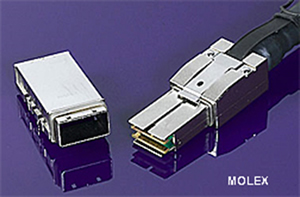 Molex has been promoting the CXP pluggable copper and fiber interface, which offers twelve 10Gb/s links in an envelope slightly larger than a QSFP+ connector.
Molex has been promoting the CXP pluggable copper and fiber interface, which offers twelve 10Gb/s links in an envelope slightly larger than a QSFP+ connector.
Molex also has been continuously expanding its iPass I/O connector family including the latest iPass+ HD in SAS-3 applications.
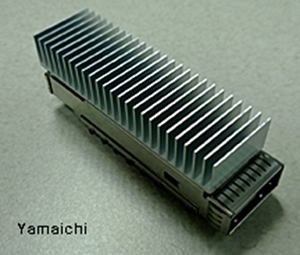
The CFP pluggable modular connector has been undergoing rapid transformation from the original 148-position CFP to the current 56-position CFP4.
The host connector delivers four channels at more than 28Gb/s each, to support 100 Gb Ethernet applications.
The design flexibility these pluggable modules offer is tempered by the power they consume and the heat generated by the electro-optic conversion process.
Active optical cables, which feature electro-optic conversion components integrated within the external connector body, have proliferated over the past few years. Active optical cable assemblies are particularly attractive when equipment with standard I/O interfaces must communicate long distances or data security is a concern.
Initially offered with industry-standard interfaces at both ends, new configurations using electrically optimized interfaces are entering the market.
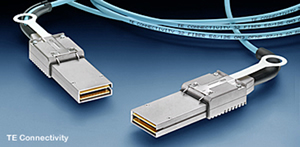 The most recent contender is the CDFP interface that is capable of delivering 16 channels at 25Gb/s each in anticipation of 400 Gb Ethernet. This active optical cable assembly can reach up to 100 meters while consuming only six watts per end.
The most recent contender is the CDFP interface that is capable of delivering 16 channels at 25Gb/s each in anticipation of 400 Gb Ethernet. This active optical cable assembly can reach up to 100 meters while consuming only six watts per end.
Each of these connectors offers variations of total bandwidth, port density, power consumption, and thermal management.
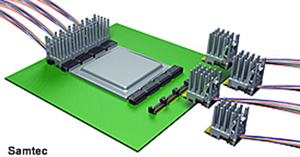
Fiber optic I/O, once the exclusive domain of long distance links, is now becoming practical in lengths of only a few meters. Mid-board optical transceivers are changing the way server boards are being architected. High-speed signals can be converted to optical links immediately adjacent to the processor to avoid distortion and loss due to PCB effects and exit via the I/O panel using a variety of high-density fiber optic connectors.
 One of the most recent new products in this category was the joint announcement by Intel and Corning of the MXC connector. This unique interface can support data rates up to 1.6 terabits per second to a maximum of 300 meters. The connector organizes up to 64 fibers running at 25Gb/s each.
One of the most recent new products in this category was the joint announcement by Intel and Corning of the MXC connector. This unique interface can support data rates up to 1.6 terabits per second to a maximum of 300 meters. The connector organizes up to 64 fibers running at 25Gb/s each.
Demand for increased bandwidth and physical size reduction is impacting every level of the computing device world. Even standard consumer-grade I/O connectors are feeling pressure to stay relevant, resulting in new iterations that dial up the data rate.
The original USB connector was introduced in 1996 with a published data rate of 12Mb/s. This ubiquitous connector has undergone a continuing series of upgrades to the upcoming USB 3.1 Type-C that will be rated up to 10Gb/s while maintaining a similar micro connector profile. Its power delivery capability has also been raised to 100 watts. The USB Implementers Forum needs to do this with the Intel Thunderbolt connector snipping at its heels.
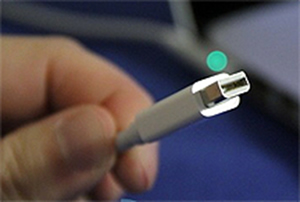 Thunderbolt 2 combines the original two 10Gb/s bi-directional channels of Thunderbolt 1 into one 20Gb/s full-duplex channel, effectively doubling the throughput of one link. These speeds enable transmission of anticipated 4K video while using the same mini DisplayPort connector. Thunderbolt 2 utilizes active components integrated into the cable assembly, so cost will still be a factor in general market acceptance.
Thunderbolt 2 combines the original two 10Gb/s bi-directional channels of Thunderbolt 1 into one 20Gb/s full-duplex channel, effectively doubling the throughput of one link. These speeds enable transmission of anticipated 4K video while using the same mini DisplayPort connector. Thunderbolt 2 utilizes active components integrated into the cable assembly, so cost will still be a factor in general market acceptance.
The HDMI connector has continued to evolve with the approval of version 2.0, which bumps the throughput from 3.4 to 6Gb/s, along with a number of additional performance enhancements.
Even the lowly modular plug-and-jack connector has demonstrated remarkable ability to keep pace with technology. Developed by Bell Labs in 1975, the elegant design and simple termination process was focused on the ability to conduct audio frequencies over extended product lifetimes in often harsh environments. The unique gold-plated contact and insulation displacement termination process proved to be incredibly reliable and was adopted in a wide range of applications well beyond its telecom roots. Nearly 40 years later, the evolved RJ45 connector is capable of supporting 10Gb Ethernet applications while retaining its advantages of compact design and extreme low cost.
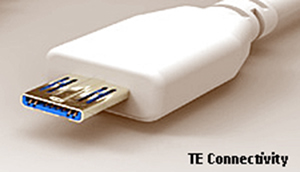 New applications will continue to drive development of next-generation I/O connectors. The rapidly expanding markets for mobile devices including smartphones, navigation, and wearable electronics spurred TE Connectivity to introduce its High Speed Multiple I/O connector that features USB 3.1 speed of 10Gb/s, the ability to deliver up to 3 amps of power, and is packaged in Micro USB 2.0 form factor.
New applications will continue to drive development of next-generation I/O connectors. The rapidly expanding markets for mobile devices including smartphones, navigation, and wearable electronics spurred TE Connectivity to introduce its High Speed Multiple I/O connector that features USB 3.1 speed of 10Gb/s, the ability to deliver up to 3 amps of power, and is packaged in Micro USB 2.0 form factor.
The continuing mantra of faster, smaller, longer reach, and, of course, cheaper continues to define the world of input/output connectors as design engineers seek to avoid the dreaded I/O bottleneck.
Robert Hult, Market Director, Bishop & Associates, Inc.
- Optics Outpace Copper at OFC 2024 - April 16, 2024
- Digital Lighting Enhances your Theatrical Experience - March 5, 2024
- DesignCon 2024 in Review - February 13, 2024





